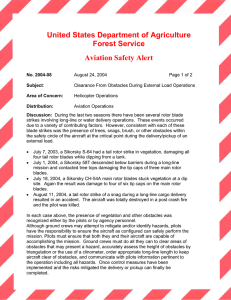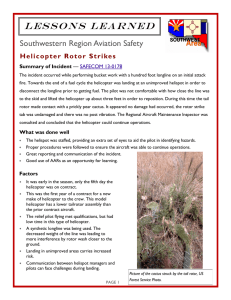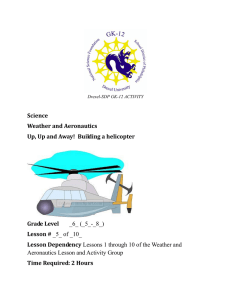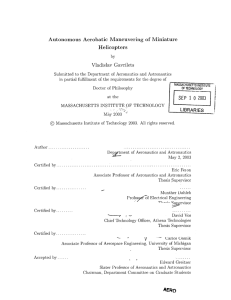Document 10511124
advertisement
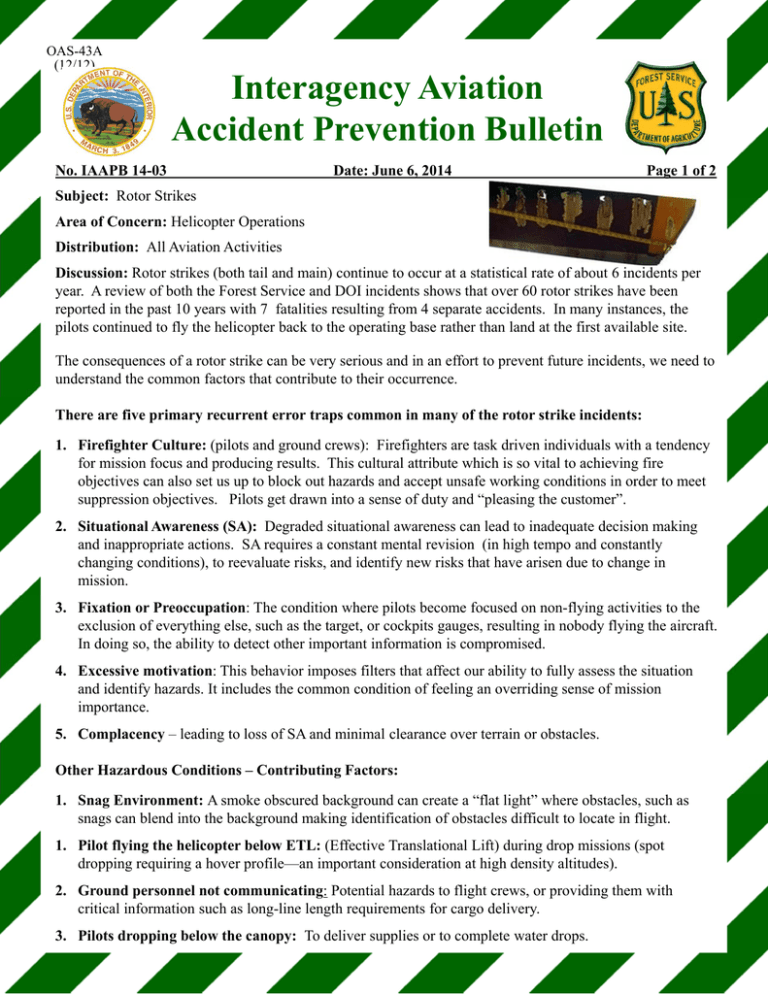
OAS-43A (12/12) Interagency Aviation Accident Prevention Bulletin No. IAAPB 14-03 Date: June 6, 2014 Page 1 of 2 Subject: Rotor Strikes Area of Concern: Helicopter Operations Distribution: All Aviation Activities Discussion: Rotor strikes (both tail and main) continue to occur at a statistical rate of about 6 incidents per year. A review of both the Forest Service and DOI incidents shows that over 60 rotor strikes have been reported in the past 10 years with 7 fatalities resulting from 4 separate accidents. In many instances, the pilots continued to fly the helicopter back to the operating base rather than land at the first available site. The consequences of a rotor strike can be very serious and in an effort to prevent future incidents, we need to understand the common factors that contribute to their occurrence. There are five primary recurrent error traps common in many of the rotor strike incidents: 1. Firefighter Culture: (pilots and ground crews): Firefighters are task driven individuals with a tendency for mission focus and producing results. This cultural attribute which is so vital to achieving fire objectives can also set us up to block out hazards and accept unsafe working conditions in order to meet suppression objectives. Pilots get drawn into a sense of duty and “pleasing the customer”. 2. Situational Awareness (SA): Degraded situational awareness can lead to inadequate decision making and inappropriate actions. SA requires a constant mental revision (in high tempo and constantly changing conditions), to reevaluate risks, and identify new risks that have arisen due to change in mission. 3. Fixation or Preoccupation: The condition where pilots become focused on non-flying activities to the exclusion of everything else, such as the target, or cockpits gauges, resulting in nobody flying the aircraft. In doing so, the ability to detect other important information is compromised. 4. Excessive motivation: This behavior imposes filters that affect our ability to fully assess the situation and identify hazards. It includes the common condition of feeling an overriding sense of mission importance. 5. Complacency – leading to loss of SA and minimal clearance over terrain or obstacles. Other Hazardous Conditions – Contributing Factors: 1. Snag Environment: A smoke obscured background can create a “flat light” where obstacles, such as snags can blend into the background making identification of obstacles difficult to locate in flight. 1. Pilot flying the helicopter below ETL: (Effective Translational Lift) during drop missions (spot dropping requiring a hover profile—an important consideration at high density altitudes). 2. Ground personnel not communicating: Potential hazards to flight crews, or providing them with critical information such as long-line length requirements for cargo delivery. 3. Pilots dropping below the canopy: To deliver supplies or to complete water drops. No. IAAPB 14-03 Date: June 6, 2014 Page 2 of 2 Prevention: Some prevention measures to control risk and avoid rotor strikes include: High/low - level recons: Familiarize yourself with the area you are working, make note of emergency landing areas in case something goes wrong. Complete a high level recon of the area before the drop; give consideration to the wind, terrain, sun angle, etc. Continually assess hazards and maintain SA: Constantly applying the “What could go wrong” into your rapid risk assessment. Don’t get drawn into the desire to please the customer and push the aircraft to its limitations. Remain above the canopy and operate according to the Interagency Helicopter Operations Guide (IHOG), Chapter 11, paragraph XIII D3, 4 as cited below: “In areas of sloping terrain or with obstacles rising to one or more sides of the cargo pickup/drop off area, or dipsite, the pilot shall maintain rotor clearance from all obstacles equivalent to the IHOG Chart 8-1 landing area safety circle requirements.” Wind Restrictions: Review the IHOG Chapter 6.2 for Type 1, 2 and 3 helicopters. Refuse the mission or offer an alternative solution: when obstacles present a risk of contact with aircraft or rotor blades, the pilot should decline the mission until hazards are removed. Communicate: In the cockpit and with the people on the ground; ground crews must assess hazards in the drop zone and communicate potential hazards to the flight crew---it’s a TEAM effort. Land the Damn Helicopter (HAI Presidents message): In several of the rotor strikes the helicopter was flown back to the operating base when there were several opportunities to land to assess the damage. Continuing to fly, regardless of how minor it may seem, presents unnecessary and unknown risks. Study Mountain Flight Characteristics: Flight crews should take opportunities to participate in educational opportunities that are available from several schools specializing in rotary wing mountain flying, and the AOPA has a free course on Mountain Flying at: https://flash.aopa.org/asf/mountainFlying/html/flash.cfm. Learning the unique environmental surprises that low level mountain flying brings will make us better prepared when we encounter them. Summary: Rotor strikes can be mitigated through proper risk management and effective Crew Resource Management. /s/ Keith C. Raley Chief, Aviation Safety and Program Evaluation DOI, Office of Aviation Services /s/ Gary Morgan Acting Branch Chief, Aviation Safety Management Systems USDA, Forest Service
